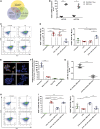Mesenchymal stromal cell-derived exosomes attenuate myocardial ischaemia-reperfusion injury through miR-182-regulated macrophage polarization
- PMID: 30753344
- PMCID: PMC6529919
- DOI: 10.1093/cvr/cvz040
Mesenchymal stromal cell-derived exosomes attenuate myocardial ischaemia-reperfusion injury through miR-182-regulated macrophage polarization
Abstract
Aims: Mesenchymal stromal cells (MSCs) gradually become attractive candidates for cardiac inflammation modulation, yet understanding of the mechanism remains elusive. Strikingly, recent studies indicated that exosomes secreted by MSCs might be a novel mechanism for the beneficial effect of MSCs transplantation after myocardial infarction. We therefore explored the role of MSC-derived exosomes (MSC-Exo) in the immunomodulation of macrophages after myocardial ischaemia/reperfusion (I/R) and its implications in cardiac injury repair.
Methods and results: Exosomes were isolated from the supernatant of MSCs using gradient centrifugation method. Administration of MSC-Exo to mice through intramyocardial injection after myocardial I/R reduced infarct size and alleviated inflammation level in heart and serum. Systemic depletion of macrophages with clodronate liposomes abolished the curative effects of MSC-Exo. MSC-Exo modified the polarization of M1 macrophages to M2 macrophages both in vivo and in vitro. miRNA sequencing of MSC-Exo and bioinformatics analysis implicated miR-182 as a potent candidate mediator of macrophage polarization and toll-like receptor 4 (TLR4) as a downstream target. Diminishing miR-182 in MSC-Exo partially attenuated its modulation of macrophage polarization. Likewise, knock down of TLR4 also conferred cardioprotective efficacy and reduced inflammation level in a mouse model of myocardial I/R.
Conclusion: Our data indicate that MSC-Exo attenuates myocardial I/R injury in mice via shuttling miR-182 that modifies the polarization status of macrophages. This study sheds new light on the application of MSC-Exo as a potential therapeutic tool for myocardial I/R injury.
Keywords: Exosomes; Macrophage polarization; Mesenchymal stromal cells; MicroRNA; Myocardial ischaemia/reperfusion injury.
© The Author(s) 2019. Published by Oxford University Press on behalf of the European Society of Cardiology.
Figures






Similar articles
-
Nicorandil-Pretreated Mesenchymal Stem Cell-Derived Exosomes Facilitate Cardiac Repair After Myocardial Infarction via Promoting Macrophage M2 Polarization by Targeting miR-125a-5p/TRAF6/IRF5 Signaling Pathway.Int J Nanomedicine. 2024 Feb 29;19:2005-2024. doi: 10.2147/IJN.S441307. eCollection 2024. Int J Nanomedicine. 2024. PMID: 38469055 Free PMC article.
-
miRNA-181a over-expression in mesenchymal stem cell-derived exosomes influenced inflammatory response after myocardial ischemia-reperfusion injury.Life Sci. 2019 Sep 1;232:116632. doi: 10.1016/j.lfs.2019.116632. Epub 2019 Jul 3. Life Sci. 2019. PMID: 31278944
-
Nanoparticle incorporating Toll-like receptor 4 inhibitor attenuates myocardial ischaemia-reperfusion injury by inhibiting monocyte-mediated inflammation in mice.Cardiovasc Res. 2019 Jun 1;115(7):1244-1255. doi: 10.1093/cvr/cvz066. Cardiovasc Res. 2019. PMID: 30851101
-
The Potential of Mesenchymal Stem Cell-Derived Exosomes in Cardiac Repair.Int J Mol Sci. 2024 Dec 17;25(24):13494. doi: 10.3390/ijms252413494. Int J Mol Sci. 2024. PMID: 39769256 Free PMC article. Review.
-
Mesenchymal Stem Cell-Derived Exosomal microRNAs in Cardiac Regeneration.Cells. 2023 Dec 11;12(24):2815. doi: 10.3390/cells12242815. Cells. 2023. PMID: 38132135 Free PMC article. Review.
Cited by
-
Exosomes Derived from Human Umbilical Cord Mesenchymal Stem Cells Regulate Macrophage Polarization to Attenuate Systemic Lupus Erythematosus-Associated Diffuse Alveolar Hemorrhage in Mice.Int J Stem Cells. 2021 Aug 30;14(3):331-340. doi: 10.15283/ijsc20156. Int J Stem Cells. 2021. PMID: 33906978 Free PMC article.
-
Mesenchymal stem cells-derived exosomes: novel carriers for nanoparticle to combat cancer.Eur J Med Res. 2023 Dec 9;28(1):579. doi: 10.1186/s40001-023-01556-y. Eur J Med Res. 2023. PMID: 38071346 Free PMC article. Review.
-
Mesenchymal stem cell-derived extracellular vesicles alter disease outcomes via endorsement of macrophage polarization.Stem Cell Res Ther. 2020 Sep 29;11(1):424. doi: 10.1186/s13287-020-01937-8. Stem Cell Res Ther. 2020. PMID: 32993783 Free PMC article. Review.
-
Therapeutic Features and Updated Clinical Trials of Mesenchymal Stem Cell (MSC)-Derived Exosomes.J Clin Med. 2021 Feb 11;10(4):711. doi: 10.3390/jcm10040711. J Clin Med. 2021. PMID: 33670202 Free PMC article. Review.
-
Non-coding RNAs in Cardiac Intercellular Communication.Front Physiol. 2020 Sep 9;11:738. doi: 10.3389/fphys.2020.00738. eCollection 2020. Front Physiol. 2020. PMID: 33013428 Free PMC article. Review.
References
Publication types
MeSH terms
Substances
LinkOut - more resources
Full Text Sources
Medical
Molecular Biology Databases

